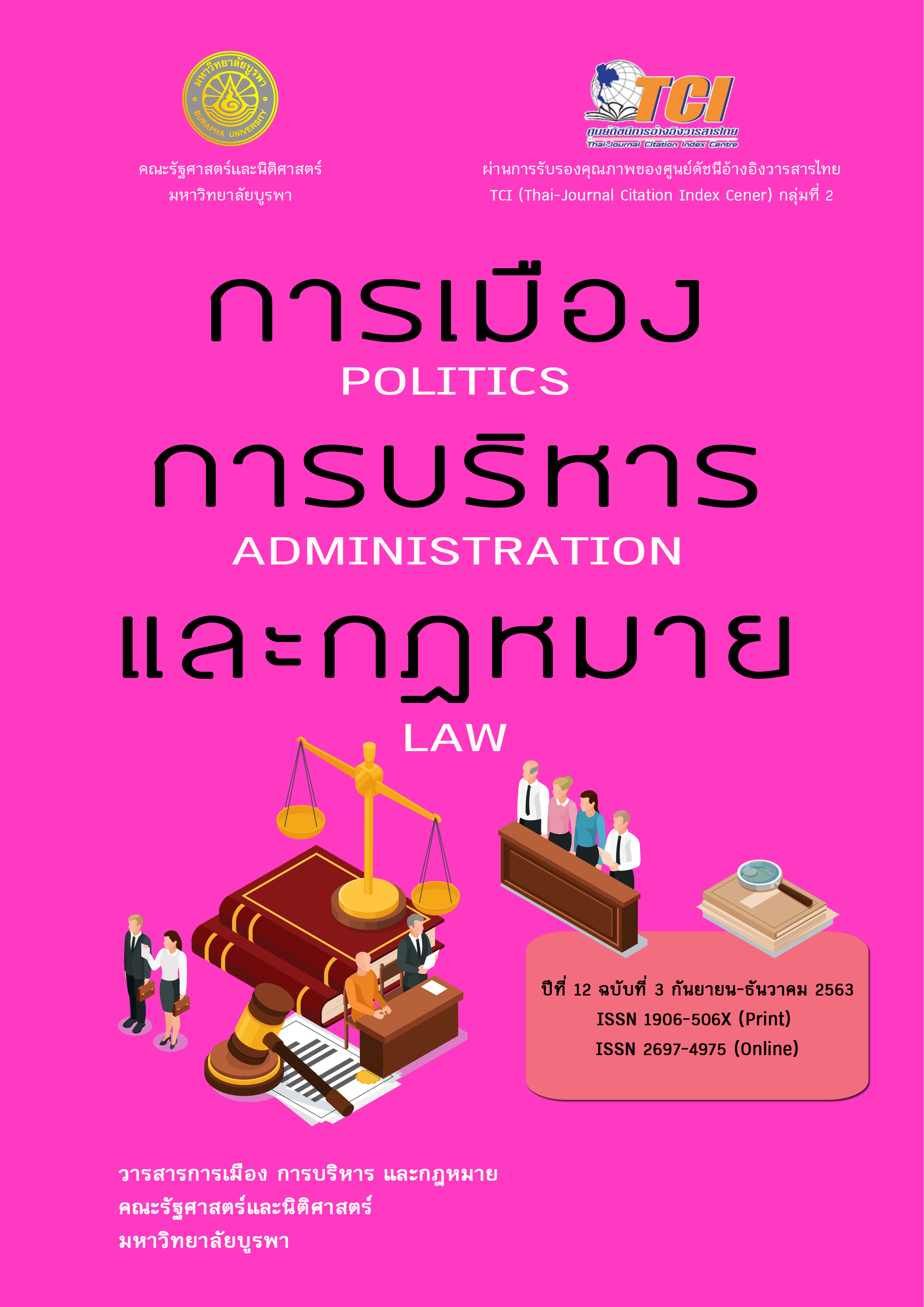The Public Policy Model for Developing Potential of Agricultural Community Enterprise in the Eastern Economic Corridor
Keywords:
Public policy, Potential, Agricultural community enterprises, Eastern Economic CorridorAbstract
This research aims to study the developing policy that driven to increase the potential of agricultural community enterprises in the Eastern Economic Corridor. A qualitative research model was conducted in-depth interviews of 18 experts and 8 experts for discussions in focus group to confirm research results and exchange other useful ideas. The study results that the developing policy that driven to increase the potential of agricultural community enterprises in the Eastern Economic Corridor divided into 10 areas as 1) Organization management, Promote and develop the group to be strong by giving members a stable and sustainable income. 2) Potential analysis for continuous improvement and development. 3) Promoting and developing the potential of community enterprises in terms of personnel and management. 4) Funding for the establishment of a stable community enterprises fund. 5) Improvement and development of community enterprise standards regularly. 6) Sharing and returning to society. 7) The participation of all community enterprise members. 8) Fair and equal benefits management for community enterprise members. 9) The provision of welfare for members of community enterprises and 10) Management and organizational structure.
References
กรมส่งเสริมการเกษตร. (2556). การพัฒนาองค์กรเกษตรกร วิสาหกิจชุมชน และเครือข่าย. กรุงเทพฯ: ชุมชนสหกรณ์การเกษตรแห่งประเทศไทย.
กระทรวงเกษตรและสหกรณ์. (2559). แผนพัฒนาการเกษตร ในช่วงแผนพัฒนาเศรษฐกิจและสังคมแห่งชาติ ฉบับที่ 12 (พ.ศ. 2560-2564). วันที่ค้นข้อมูล 20 มีนาคม 2561, เข้าถึงได้จาก http://www.oae.go.th/ download/journal/development_plan2559.pdf
กลุ่มทะเบียนและสารสนเทศวิสาหกิจชุมชน. (2562). สรุปจำนวนวิสาหกิจชุมชนและเครือข่ายวิสาหกิจชุมชนที่อนุมัติการจดทะเบียนแล้ว. วันที่ค้นข้อมูล 15 เมษายน 2562, เข้าถึงได้จาก https://www.m-society.go.th/ewt_news.php?nid=18750
กองนโยบายและแผนพัฒนาการเกษตร สำนักงานเศรษฐกิจการเกษตร. (2561). สถิติการค้าสินค้าเกษตรไทยกับต่างประเทศปี 2561. วันที่ค้นข้อมูล 24 ธันวาคม 2561, เข้าถึงได้จาก http://www.oae.go.th/assets/portals/1/files/ebook/2562/tradestat61.pdf
กองส่งเสริมวิสาหกิจชุมชน. (2558). ยุทธศาสตร์ส่งเสริมวิสาหกิจชุมชน. วันที่ค้นข้อมูล 13 มีนาคม 2561, เข้าถึงได้จาก http://www.sceb.doae.go.th/Documents/Strategy_sceb.pdf
คณะรักษาความสงบแห่งชาติ. (2560). การพัฒนาระเบียงเศรษฐกิจพิเศษภาคตะวันออก. วันที่ค้นข้อมูล 20 มกราคม 2561, เข้าถึงได้จาก www.eeco.or.th
ธงพล พรหมสาขา ณ สกลนคร และอุทิศ สังขรัตน์. (2556). แนวทางการพัฒนาการดำเนินงานของวิสาหกิจชุมชนในเขตลุ่มทะเลสาบสงขลา. โครงการวิจัย ภาควิชาสารัตถศึกษา, คณะศิลปศาสตร์, มหาวิทยาลัยสงขลานครินทร์.
นพรัตน์ ธำรงทรัพย์. (2559). คู่มือแนวทางสินค้าการตลาด OTOP. กรุงเทพฯ: ฉัตร (บิ๊ก ไอเดีย คัม ทู ไลฟ์).
ประภาพรรณ รักเลี้ยง, จิติมา วรรณศรี, ฉลอง ชาตรูประชีวิน และวิทยา จันทร์ศิลา. (2556). แนวทางการบริหารความเสี่ยงด้านการปฏิบัติงานที่มีผลต่อประสิทธิผลงานวิชาการในมหาวิทยาลัยเอกชน ภาคเหนือตอนล่าง. พิษณุโลก: ทุนสนับสนุนการวิจัย มหาวิทยาลัยพิษณุโลก.
พสุ เดชะรินทร์. (2551). Balanced scorecard รู้ลึกในการปฏิบัติ 2552. กรุงเทพฯ: โรงพิมพ์แห่งจุฬาลงกรณ์มหาวิทยาลัย.
ไพศาล มุ่งสมัคร และคณะ. (2558). รูปแบบการจัดการที่ประสบผลสำเร็จของกลุ่มเครือข่ายวิสาหกิจชุมชนผลิตภัณฑ์สมุนไพร กลุ่มจังหวัดนครชัยบุรินทร์. วารสารสมาคมนักวิจัย, 18(3), 23-26.
สัญญา เคณาภูมิ. (2558). แนวทางการพัฒนาประสิทธิผลของวิสาหกิจชุมชนในเขตพื้นที่จังหวัดมหาสารคาม. วารสารวิชาการแพรวากาฬสินธุ์ มหาวิทยาลัยกาฬสินธุ์, 2(3), 55-60.
สำนักงานเลขานุการคณะกรรมการส่งเสริมวิสาหกิจชุมชน. (2555). คู่มือการประเมินศักยภาพวิสาหกิจชุมชน. วันที่ค้นข้อมูล 25 มกราคม 2562, เข้าถึงได้จาก http://smce.doae.go.th/
สุพจน์ อินหว่าง . (2558). แนวทางการพัฒนาวิสาหกิจชุมชน. กรุงเทพฯ: มีน เซอร์วิส ซัพพลาย.
สุมาลี สันติพลวุฒิ และรสดา เวษฎาพันธุ์. (2558). การประเมินผลการดำเนินงานของวิสาหกิจชุมชน: กรณีศึกษาการลงทุนพัฒนาเครื่องผลิตแผ่นข้าวตังของวิสาหกิจชุมชนโสธรพัฒนา จังหวัดฉะเชิงเทรา. วารสารเกษตรศาสตร์ (สังคม), 36(3), 437-447.
อินท์ชลิตา วัชรีจิระโชติ. (2556). การศึกษาเปรียบเทียบการจัดการวิสาหกิจชุมชน กลุ่มผลิตผ้าไหม อำเภอบ้านเขว้า และกลุ่มผลิตผ้าไหม อำเภอคอนสวรรค์ จังหวัดชัยภูมิ. วารสารวิชาการบริหารธุรกิจ, 2(2), 47-63.
Assessment Association International. (2009). Assessing Potential. Retrieved August 23, 2018, from https://aai-assessment.com/thought-leadership/assessing-potential
Allo, A. V. (1982). The farm advisor: a discussion of agricultural extension for. developing Countries Taiwan: Food and Fertilizer Technology Center. Taipei: Food and Fertilizer Technology Center.
Al-Tit, A., Omri, A., & Euchi, J. (2019). Critical Success Factors of Small and Medium-Sized Enterprises in Saudi Arabia: Insights from Sustainability Perspective. Administrative Science, 9(32), 1-12.
Anderson, J. E. (1994). Public policy-making: An introduction (2nd ed.). New York: Mifflin.
Magnanelli, B. S., Raoli, E., & Sacchi, A. (2016). Key Factors for Success of Social Enterprises in Italy: Analysis of Financial and Operating Performance. Review of Economics & Finance, 6, 43-60.
Barone, A. (2019). Social Enterprise. Retrieved August 23, 2018, from https://www.investopedia.com/terms/s/social-enterprise.asp
Considine, M. (1994). Public Policy: A Critical Approach. South Melbourne, Australia: MacMillan.
Dye, T. R. (1984). Understanding Public Policy (5th ed). Englewood Cliffs. New Jersey: Prentice -Hall, Inc.
Easton, D. (1953). The Political System. New York: Knopt.
Eulau, H., & Prewitt, K. (1973). Labyrinths of Democracy. Indianapolis: Bobbs- Merril.
Friedrich, C. J. (1963). Constitutional Government. New York: McGraw - Hill.
Heclo, H. H. (1972). Review article: policy analysis. British Journal of Political Science, 2(1), 83-108.
Jurevicius, O. (2013). Strategic Management & Strategic Planning. Retrieved September 22, 2019, from https://www.strategicmanagementinsight.com/topics/strategic-management-planning.html
Marc, J. L. (2011). Social enterprise: empowering mission-driven entrepreneurs. Chicago, Ill.: American Bar Association.
Mathew, P. M. (2008). Social Enterprises in the Competitive Era. Economic and Political Weekly, 43(38), 22–24.
McLagan, P. A. (1997). Competencies: The Next Generation. Training & Development, 51(4), 40-47.
Mosher, A. T. (1976). Thinking About Rural Development. New York: The Agricultural Development Coouncil.
Porter, M. E. (1990). The Competitive Advantage of Nations. New York: Free Press.
Premuzic, T. C., & Pillans, G. (2018). Assessing Potential. CRF Cooperate Research Forum, 1, 2-9.
Prewitt, K., & Verba, S. (1983). An introduction to American government (4th ed.). New York: Harper & Row.
Satar, M., & John, S. (2016). A conceptual model of critical success factors for Indian social enterprises. World Journal of Entrepreneurship, Management and Sustainable Development, 12(2), 1-10.






